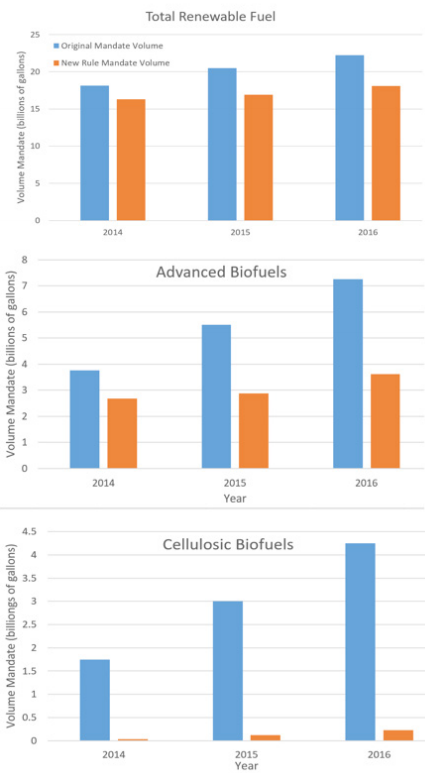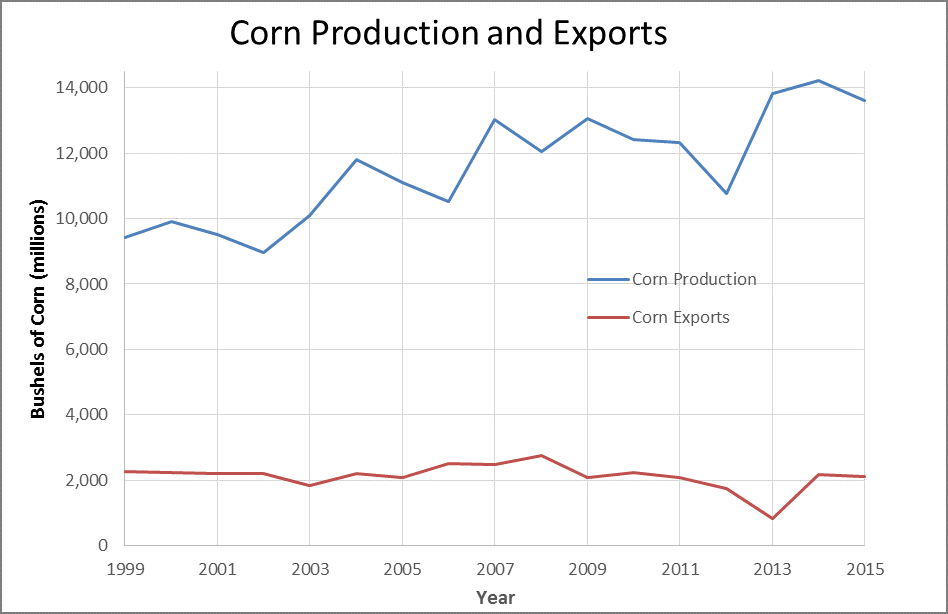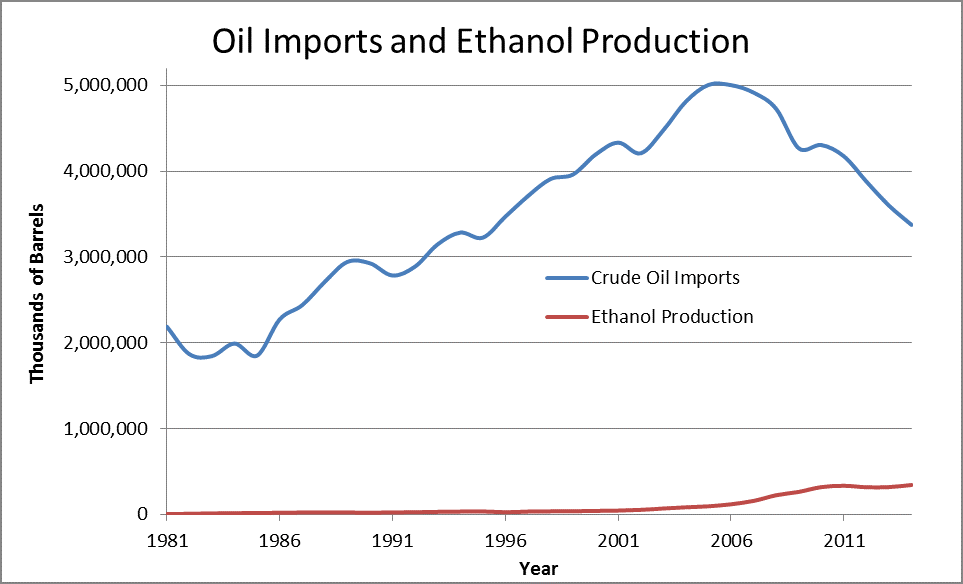
Despite its political difficulty, lawmakers should strive to repeal the ethanol mandate and remove federal support for corn-based biofuels.
Introduction
Since implementation of the Energy Policy Act in 2005, the United States has mandated a certain amount of renewable auto fuels be produced each year, a policy known as the Renewable Fuel Standard (RFS). The RFS was modified in 2007 with the Energy Independence and Security Act, and was last year subjected to a rule adjustment by the Environmental Protection Agency (EPA). The new rule stipulates the United States will consume 18.11 billion gallons of renewable fuel in 2016.
This change represents a downgrade from the originally mandated volumes, which called for 22.25 billion gallons of renewable fuel this year (see Figure 1). Nearly all of this downgrade has come from the cleanest portion of the mandate, cellulosic and advanced biofuels. Due to a myriad of issues to be discussed below, use of renewable fuels from bio-based sources, particularly the most efficient and clean variety, has simply failed to grow at the rate expected or hoped for by ethanol supporters.

Subsidies and Support
Ethanol producers and corn-growers have received both implicit support through federal mandates as well as subsidies from the Federal government to encourage production. Though the direct subsidy for ethanol, known as the Volumetric Ethanol Excise Tax Credit, expired in 2011, it had already cost taxpayers almost $30 billion since its enactment in 20041 . Fueling stations still receive a federal tax credit for installing blend-fuel pumps, though the credit also applies to installation of LNG, LPG, and electric vehicle ports. Advanced biofuels like biodiesel and cellulosic ethanol are still supported by federal dollars for research and production2
Some politicians, including Rep. Peter Welch (D-Vt.) have called for an end to the corn-based ethanol mandate which makes up nearly three-quarters of the RFS3 . Under the original EPA rule, the United States was slated to increase its renewable fuel usage each year until at least 2022 in an effort to reduce dependence on foreign oil and minimize greenhouse gas emissions. If technology and production continue to fall short of expectations, and as criticisms of the environmental impacts and of the cost of subsidies for the industry grow, opposition to the rule will likely gain ground. Is it time to end the RFS? Has it been, as Representative Welch calls it, “a well-intentioned flop?”
Greenhouse Gas Emissions Reduction: An Advanced Biofuel Game
The new final rule calls for a total volume of 18.11 billion gallons of “renewable fuels” and a further breakdown requires at least 1.90 billion gallons of biodiesel and 3.61 billion gallons of advanced biofuels, with the remainder coming from traditional biofuels, typically corn ethanol4 .
Under the RFS, anything termed a “renewable fuel” must offer at least 20% greenhouse gas reductions over traditional gasoline, while “advanced biofuels” must reduce emissions by at least 60%. Biodiesel would need to reduce emissions by 50% over traditional diesel. These rates are also, importantly, based on capacity from production facilities constructed “after the date of enactment” of the EISA in 2007. Old facilities producing biofuels still count toward the volume mandates even if they fail to meet emission reduction standards. This means nearly half the current biofuel production capacity has been “grandfathered” in without regard to emissions reductions5 .6 .
The total emissions generated in production and use is influenced by the production process of the fuel. For corn-grain ethanol this production process occurs either by wet or dry milling, the main difference being that wet milling allows separation and sale of other by-products of the grain before the production of the ethanol. Farmers and scientists find dry-milling produces a higher ethanol yield per acre, while wet milling allows for a greater diversity of products7 8 . After grain separation in wet milling (or immediately in dry-milling) the grain is ground to a powdered meal and added to a slurry of water and enzymes to create smaller sugars which are then fermented to form high-purity alcohol. Finally, the high purity alcohol is blended with petroleum-based gasoline for use in a vehicle[8]. This mixture is known as a blended fuel and is the most common form of renewable fuel used in the United States, referred to by names such as E10, E15, and E85 (10%, 15% and 85% ethanol content respectively). In 2014, the U.S. produced 14.3 billion gallons of this type of fuel ethanol9 .
E10 is by far the most prominent fuel in the U.S., and the small motor industry, as well as the automobile industry, has resisted breaking what they refer to as the “blend wall” of E10. Industry argues higher concentration ethanol blends can damage engines and the Department of Energy warns that using fuel blends above 10% in small engines, boats, and pre-2001 passenger vehicles could cause damage and is prohibited by law10. Without room to break the “blend wall” however, the market for ethanol in the United States is limited; 95% of gasoline consumed in the United States is already E1011. Despite this clear barrier, the 2016 volume targets will almost certainly require a breaking of the blend wall12.
While dominant in the United States, corn is not the only source for bio-based fuels. In Brazil, for example, sugar cane is the main source for ethanol fuel. Notably, sugar cane has a fuel yield nearly eight times that of corn and a much more favorable energy balance. That is, when putting the same amount of energy in to producing ethanol from either source, sugarcane produces far more output energy13.
While more desirable as a feed-stock for ethanol from an energy standpoint, a 2006 USDA study found sugarcane-based ethanol would fail to compete economically with the far more available corn product in the United States14 .
Cellulosic ethanol falls under the “advanced biofuels” category, and its development has been growing slowly. Commercial sized productions, such as a planned DuPont site in Iowa, aim to produce relatively small quantities (30 million gallons in this case) of cellulosic fuel—well short of the billions of gallons required in the original RFS mandates15 . Whereas traditional ethanol uses the grains of a plant, cellulosic ethanol would aim to take the whole plant: the stalk, husk, and shell in the case of corn. This option is attractive, because it removes the food-vs-fuel debate from ethanol production. Most of the feed stream for cellulosic ethanol would be bio-waste or non-food based plants such as switchgrass. Breaking down cellulose, a chemically powerful combination of small sugars which resists being separated into the component parts necessary for fuel production, however, has proven difficult. Currently, expensive catalysts or energy-intensive processes are required, limiting the economic and environmental benefits of the conversion. One study, by the National Renewable Energy Lab, found a minimum required gasoline price of $3.27/gallon for cellulosic fuel to be economical16. Because of these hurdles, production of cellulosic fuels has failed to meet the targets set in the original RFS.
This failure points to disappointing results for greenhouse gas emission reductions planned for in the RFS. Corn-based ethanol emissions have been criticized by many; large-scale agriculture produces 2.5% of total U.S. greenhouse gas emissions, and nitrogen and phosphorous fertilizers used to increase corn yields are responsible for 86% of the agricultural sector’s emissions17 . Nobel Prize-winning chemist P.J. Crutzen, weighed in on the issue, noting the excess N2O (a greenhouse gas with 300 times the warming potential of CO2) released during the production of ethanol means corn-based ethanol “contributes as much or more to global warming” than traditional petroleum-based fuel18 19. Beyond the N2O released in the process, emissions and energy life-cycle analyses for corn-based ethanol have produced mixed results.
A study by the National Resource Council challenged the EPA’s assertion that corn-based ethanol offers at least a 20% emissions reduction over gasoline, saying there are “plausible scenarios in which GHG emissions from corn-grain ethanol are much higher than those of petroleum-based fuels”20 .
Summarizing several studies on the issue, the Congressional Budget Office noted in 2014 that while estimates of emissions reductions (or increases) vary, the failure to show a clear and consistent benefit from switching to corn ethanol over gasoline implied traditional biofuels offered only “limited potential” to reduce overall emissions. The CBO study further notes that potential emission reductions from the RFS would have to come chiefly from expanded use of cellulosic biofuel and other advanced biofuels, rather than from the corn-grain ethanol21. Notably, the mandates for increased production and use of advanced biofuels were reduced when the EPA adjusted its targets in the most recent final rule—essentially removing the key emissions-saving part of the mandate.
Food Prices, Water Issues and Land Use
Beyond failing to reduce greenhouse gas emissions, there are concerns the RFS mandates have had negative effects on other parts of the environment, as well as on global food markets. Ethanol production has been accused of putting upward pressure on food prices, of increasing environmental degradation due to land-clearance, and of increased water nitrification due to increased use of chemical fertilizer.
The use of ethanol has also been criticized on a water-use efficiency basis. A report commissioned by the Department of Energy found producing a gallon of corn ethanol could use anywhere from 10 to 324 gallons of water, depending on where the corn was grown. In contrast, a gallon of gasoline produced from crude oil required 2.6 to 6.6 gallons of water22.
There is also concern about the damage increased industrial farming can have on the nation’s water systems. According to a brief prepared by the Union of Concerned Scientists, nearly a third of the nation’s streams and rivers contain unsafe levels of nitrogen and phosphorous—two key elements in fertilizer used for large agriculture operations23. Introducing nitrogen and phosphorous into rivers and streams not only makes the water unsafe to drink; the collective drainage eventually makes its way back to the Mississippi delta and out into the Gulf of Mexico where massive “dead zones” have formed (Figure 2) due to hypoxia, or a lack of dissolved oxygen, caused by excess algae growth stimulated by the fertilizer run-off.

The effect on food prices is one of the most persistent controversies surrounding the ethanol debate. A 2009 report by the CBO attributed approximately 15% of the total rise in food prices in the United States from 2008 to 2009 to increased ethanol production, though it also noted that other factors such as energy prices had a far larger effect24 . While the 2009 report noted that food prices are higher than would otherwise be the case due to the RFS, a 2015 report by the CBO concluded that continuing or repealing the RFS would have little or no effect on U.S. food prices going forward25 .
Global food prices may be another question entirely, however. A study by Lagi et al from 2012, which built a model for global food prices, found ethanol production and price speculation to be the two dominant drivers behind a rise in food prices in 2011 and 2012, a price hike which is thought to have contributed to social unrest and the upheavals of the so-called “Arab Spring” in those years26. For our Southern neighbor, ethanol policies may have been particularly devastating. Lagi et al found Mexican corn import prices were inflated by 27% due to ethanol production in the United States.
The increased emphasis on agriculture for fuel production also has the potential to reduce America’s forested or prairie lands. These areas are important from an emissions perspective: they serve as “carbon sinks,” by storing carbon in the plants and trees. Land-use has been a major concern for Brazil where mass tracts of the rainforest have been cut down to make way for sugarcane production, but is also a relevant concern in the United States, as devoting more land to agriculture can amplify many of the negative impacts discussed above27.
Foreign Oil Dependence

Ethanol was also billed as another attempt to reduce America’s “dependence” on foreign oil imports, particularly from the volatile Persian Gulf region.
In the bio-versus-petroleum-fuel debate, the question of energy content plays an important role. Petroleum-based gasoline is used ubiquitously as a transportation fuel due to its high energy density, but a gallon of ethanol contains only about 70% of the energy of a gallon of gasoline, and is heavier than its more energy-dense counterpart28 . For consumers, this translates to a drop in vehicle miles per gallon (about 3% for E10, according to the EIA)29 .
Oil imports did peak with implementation of the RFS in 2005, but the timing has been purely coincidental. The dramatic expansion in U.S. production of crude oil has led to the reduced demand for imported oil, not a large-scale switch to renewable fuels (Figure 4).

Producing massive amounts of biofuels in the United States through RFS policies and subsidies has not reduced dependence on oil imports, has failed to reduce greenhouse gas emissions, and consumed large quantities of land, water, and chemical fertilizer products. It has also slightly increased global food prices and caused other environmental damage.
Furthermore, the mandate is inflexible, requiring a specific volume of fuel each year regardless of driving trends and the performance of the economy and oil prices. If the economy shrinks and Americans use less gasoline than expected, meeting a set volume target will be even harder and more costly. Cheap gasoline also makes switching to other fuels economically burdensome, making the standard much harder to meet and exacerbating the economic costs of the mandate. Conversely, with high oil prices a fixed standard may be inadequately low.
Even with a flexible mandate, how desirable is a policy that may encourage more driving and more use of fuels? Reducing the price of transportation fuels by subsidizing biofuels may have the unintended consequence of promoting fuel consumption. This and other “unintended consequences” of RFS policies were analyzed and quantified by Holland, Hughes, Knittel and Parker (2015)30 . They concluded that the social costs of RFS policies were substantially higher compared to the social costs of a cap and trade policy.
Given the failure to achieve its goals and with so much evidence stacked against it, it seems well past time to revoke the RFS altogether, however, the debate surrounding ethanol has been a particularly hard-sticking point for both parties. One theory: that Iowan’s position as first-in-the-nation voters for presidential election primaries pushes candidates to support the RFS in an agriculture-heavy state, gained greater traction recently when Iowa governor Terry Branstad called for voters to reject Republican presidential candidate Senator Ted Cruz for his tepid support of ethanol production and his calls to repeal the RFS31 . Mr. Cruz, however, went on to win the caucus.
This theory is analyzed by Holland et al in a 2011 paper, which demonstrated that while alternative methods for emissions reduction like Cap and Trade provided greater net benefits (or alternatively, lower costs), the benefit distribution across society as a whole failed to generate significant support—no one group of people would gain significantly to justify ardent support from that group32 . Ethanol, on the other hand, generated significant support in areas with large agricultural populations, thus providing a concentrated special interest to advocate on behalf of the farmers and ethanol supporters.
Senator Cruz’s victory in Iowa despite opposition to this controversial measure may have changed the game with regards to the RFS. Senator Bill Cassidy (R-La) introduced an amendment to the Bipartisan Energy Bill currently working through the Senate which would repeal the RFS as well. Though this amendment looks likely to fail, it demonstrates the growing opposition to the RFS. Despite its political difficulty, lawmakers should strive to repeal the ethanol mandate and remove federal support for corn-based biofuels, reinvesting effort and dollars in more promising areas of emissions reduction and energy independence.
Thanks to Cory Colijn from the Kleinman Center and Professor Mark Jacobsen from the University of California, San Diego for their valuable comments.
Dillon Weber
Research AssistantDillon Weber was a research fellow at the Kleinman Center and a graduate of the University of Pennsylvania majoring in chemical and biomolecular engineering and economics.
- Hanna, Autumn. “Big Oil, Big Corn: An in-Depth Look at the Volumetric Ethanol Excise Tax Credit.” Taxpayers for Common Sense (June 23, 2011). [↩]
- Taxpayer Supports for Corn Ethanol in Federal Legislation.” Taxpayers for Common Sense (June, 2013). [↩]
- Cama, Timothy. “Rep Welch: Ethanol Mandate ‘Killing’ Farmers.” The Hill, April 10, 2014, sec. Energy & Environment. [↩]
- Energy Independence and Security Act of 2007, Public Law P.L. 110-140, (2007): Title II, Section 203. [↩]
- Energy Independence and Security Act of 2007, Public Law P.L. 110-140, (2007): Title II, Section 202a. [↩]
- Monthly Energy Review. November 2007. Energy Information Administration [↩]
- “Corn Milling: Wet vs. Dry.” AMG Engineering. http://www.amg-eng.com/blog/corn-wet-milling-vs-dry-milling/ [↩]
- “How Ethanol is made.” Renewable Fuels Association. http://www.ethanolrfa.org/how-ethanol-is-made/. [↩]
- Monthly Energy Review. December 2014. Energy Information Administration [↩]
- “Ethanol.” United States Department of Energy. https://www.fueleconomy.gov/feg/ethanol.shtml. [↩]
- “Ethanol Blends.” United States Department of Energy. http://www.afdc.energy.gov/fuels/ethanol_blends.html. [↩]
- Parker, Mario. “There Goes the ‘Blend Wall’ Keeping More Ethanol Out of Gasoline.” BloombergBusiness, Nov 30, 2015. [↩]
- Goldemberg, J., et al., The sustainability of ethanol production from sugarcane. Energy Policy (2008) [↩]
- Shapouri, Hossein et al. The Economic Feasibility of Ethanol Production from Sugar in the United States: United States Department of Agriculture, 2006. [↩]
- “Cellulosic Ethanol Plant—Neda, Iowa.” E.I. du Pont de Nemours and Company. http://www.dupont.com/products-and-services/industrial-biotechnology/adv…. [↩]
- Process Design and Economics for Biochemical Conversion of Lignocellulosic Biomass to Ethanol. Golden, Colorado: National Renewable Energy Laboratory, 2011. [↩]
- Conti, John. Emissions of Greenhouse Gases in the United States, 2009. Washington, DC: Energy Information Administration, 2009. [↩]
- Solomon, S. D. et al. Contribution of Working Group I to the Fourth Assessment Report of the IPCC, 2007. New York, NY: Cambridge University Press, 2007. [↩]
- Crutzen, P. J. “N2O Release from Agro-Biofuel Negates Global Warming Reduction by Replacing Fossil Fuels.” Atmospheric Chemistry and Physics 8, (1/29/08): 389-398. [↩]
- Committee on Economic and Environmental Impacts of Increasing Biofuels Production. Renewable Fuel Standard: Potential Environmental Effects of U.S. Biofuel Policy: National Academies Press, 2011. [↩]
- Congressional Budget Office. The Renewable Fuel Standard: Issues for 2014 and Beyond. Washington, DC: Congress of the United States, 2014. [↩]
- Wu, M., M. Wang, and S. Arora. Consumptive Water use in the Production of Ethanol and Petroleum Gasoline: Argonne National Laboratory, 2009. [↩]
- Corn Ethanol’s Threat to Water Resources. Cambridge, MA: Union of Concerned Scientists, 2011. [↩]
- Congressional Budget Office. The Impact of Ethanol use on Food Prices and Greenhouse Gas Emissions. Washington, DC: Congress of the United States, 2009. [↩]
- Dinan, Terry. Testimony on the Renewable Fuel Standard: Issues for 2015 and Beyond. Washington, DC: Congressional Budget Office, 2015. [↩]
- Marco Lagi, Alexander S. Gard-Murray and Yaneer Bar-Yam “Impact of ethanol conversion and speculation on Mexico corn imports”, New England Complex Systems Institute, http://necsi.edu/research/social/foodprices/mexico/ (May 2012) [↩]
- Gao, Yan and et al. A Global Analysis of Deforestation due to Biofuel Development: Center for International Forestry Research, 2011. [↩]
- Energy Information Administration. “Few Transportation Fuels Surpass the Energy Densities of Gasoline and Diesel.” (Feb 14, 2013). [↩]
- “How Much Ethanol is in Gasoline, and how does it affect Fuel Economy?” U.S Energy Information Administration. http://www.eia.gov/tools/faqs/faq.cfm?id=27&t=10. [↩]
- Holland, Hughes, Knittel and Parker, “Unintended Consequences of Transportation Carbon Policies”. Energy Journal, 36(3), July 2015. [↩]
- Lee, MJ. “Iowa Governor Terry Branstand Wants Ted Cruz Defeated.” CNN. http://www.cnn.com/2016/01/19/politics/terry-branstad-ted-cruz-defeat/. [↩]
- Holland, Hughes, Knittel and Parker, “Some Inconvenient Truths about Climate Change Policy: The Distributional Impacts of Transportation Policies.” National Bureau of Economic Research, September 2011. [↩]

